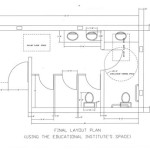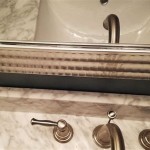Small Bathroom Vanity: The Space-Saving Solution of Wall Mount Designs
In the realm of bathroom design, maximizing space is often a primary concern, particularly in smaller bathrooms or powder rooms. The traditional floor-standing vanity, while providing ample storage, can often dominate the limited square footage, making the space feel cramped and less functional. A wall-mounted vanity presents an appealing alternative, offering a range of benefits that contribute to a more open, airy, and aesthetically pleasing bathroom environment. This article will delve into the specifics of small, wall-mounted bathroom vanities, exploring their advantages, considerations for installation, material options, and design possibilities.
The core concept behind the wall-mounted vanity is simple: it is affixed to the wall, leaving the floor area underneath completely open. This immediately creates the illusion of more space, as the eye can travel further without being interrupted by the visual mass of a traditional vanity. Furthermore, the open space beneath the vanity facilitates easier cleaning, preventing the build-up of dust and debris that can accumulate in hard-to-reach areas around floor-standing models. This design also offers a degree of flexibility in terms of installation height, allowing it to be customized to suit the specific needs and preferences of the users.
When selecting a wall-mounted vanity for a small bathroom, careful consideration must be given to the dimensions. Depth is often a crucial factor, as even a slight reduction can significantly impact the available floor space. Compact designs, often ranging from 16 to 20 inches in depth, are typically preferred in smaller bathrooms to prevent the vanity from protruding too far into the walkway. Width, too, should be proportionate to the overall size of the bathroom. While it's tempting to opt for the smallest possible vanity, it's important to ensure that it still provides adequate counter space and storage for essential toiletries.
Key Advantages of Wall-Mounted Vanities
The popularity of wall-mounted vanities stems from a multitude of advantages they offer, particularly in the context of compact bathroom spaces. These advantages extend beyond mere aesthetics and impact functionality, accessibility, and even the perceived value of the property.
Enhanced Space Perception: The most significant benefit of a wall-mounted vanity is its ability to create the illusion of increased space. By freeing up the floor area, the room feels larger and less cluttered. This is particularly beneficial in smaller bathrooms where every inch counts. The unbroken visual line from one wall to another allows the eye to perceive a greater distance, contributing to a more open and airy feel. This effect can be further amplified by choosing a vanity with a light color and a minimalist design.
Improved Accessibility and Cleaning: The open space underneath a wall-mounted vanity significantly simplifies cleaning. Mops, brooms, and vacuum cleaners can easily access the entire floor area without obstruction. This prevents the accumulation of dust, dirt, and moisture, contributing to a more hygienic and sanitary bathroom environment. Furthermore, a wall-mounted vanity can improve accessibility for individuals with mobility issues. The open space allows for greater maneuverability for wheelchairs and other assistive devices.
Customizable Height: Unlike traditional floor-standing vanities, the height of a wall-mounted vanity can be adjusted during installation. This allows it to be tailored to the specific needs of the users, promoting ergonomic comfort and reducing strain. For example, a taller individual may prefer a higher vanity to avoid excessive bending, while a family with young children might opt for a lower installation to make it easier for them to reach the sink.
Installation Considerations for Wall-Mounted Vanities
Proper installation is critical to the safety and longevity of a wall-mounted vanity. Unlike floor-standing models, which rely on their base for support, wall-mounted vanities depend entirely on the structural integrity of the wall to which they are attached. Therefore, careful planning and execution are essential.
Stud Location and Wall Reinforcement: The primary consideration is the location of the wall studs. Wall-mounted vanities must be securely anchored to these studs to provide adequate support. Drywall alone is not sufficient to bear the weight of the vanity, sink, and associated plumbing. If the location of the studs does not align with the desired vanity placement, additional reinforcement may be required. This can involve adding horizontal blocking between the studs to provide a secure mounting surface. In some cases, it may even be necessary to open up the wall and install additional studs to provide adequate support.
Plumbing Considerations: The existing plumbing configuration must also be taken into account. Wall-mounted vanities typically require adjustments to the water supply lines and drainpipe. These adjustments may involve cutting and re-routing pipes, which should be performed by a qualified plumber. It is also important to ensure that there is sufficient space behind the vanity to accommodate the plumbing connections. Pre-planning and accurate measurements are crucial to avoid costly mistakes and ensure a seamless installation.
Weight Capacity: Before installing a wall-mounted vanity, it is essential to determine the weight capacity of the wall and the mounting hardware. The weight of the vanity itself, the sink, the countertop (if applicable), and the weight of items stored inside the vanity must all be considered. It is always advisable to err on the side of caution and choose mounting hardware that exceeds the expected weight load. Failure to do so could result in the vanity detaching from the wall, causing damage and potential injury.
Materials and Design Options for Small Wall-Mounted Vanities
The market offers a wide array of materials and design options for small, wall-mounted vanities, allowing homeowners to customize their bathrooms to suit their personal style and functional needs. The choice of materials will influence not only the aesthetics of the vanity but also its durability, maintenance requirements, and overall cost.
Cabinet Materials: Common cabinet materials include wood, MDF (Medium-Density Fiberboard), plywood, and metal. Solid wood offers a classic and durable option, but it can be more expensive and susceptible to moisture damage if not properly sealed. MDF is a more affordable alternative that provides a smooth surface for painting or laminating. Plywood is a strong and stable material that is often used for the construction of vanity cabinets. Metal vanities offer a sleek and modern look and are highly resistant to moisture.
Countertop Materials: Popular countertop materials include granite, quartz, marble, solid surface, and laminate. Granite and quartz are durable and heat-resistant options that offer a luxurious look. Marble is a natural stone that provides a sophisticated and elegant aesthetic, but it is more porous and requires more maintenance than granite or quartz. Solid surface countertops are non-porous and easy to clean, making them a practical choice for bathrooms. Laminate countertops are the most affordable option, but they are less durable and resistant to scratches and stains.
Sink Styles: The choice of sink style can significantly impact the overall look of the vanity. Common options include vessel sinks, undermount sinks, and integrated sinks. Vessel sinks sit on top of the countertop, adding a unique and stylish touch. Undermount sinks are installed beneath the countertop, creating a seamless and easy-to-clean surface. Integrated sinks are molded directly into the countertop, providing a clean and minimalist look.
Design Styles: Wall-mounted vanities are available in a variety of design styles, ranging from modern and minimalist to traditional and rustic. Modern vanities often feature clean lines, sleek hardware, and neutral colors. Traditional vanities may incorporate ornate details, raised panel doors, and classic finishes. Rustic vanities often utilize natural materials, such as reclaimed wood and stone, to create a warm and inviting atmosphere.
Choosing the right small, wall-mounted vanity requires a careful balance of aesthetics, functionality, and practicality. By considering the advantages, installation requirements, material options, and design styles outlined in this article, homeowners can make informed decisions that will transform their small bathrooms into stylish and functional spaces.

Modern 36 Floating Bathroom Vanity Wall Mount Single Sink Homary Vanities Unique

Choosing The Perfect Wall Mounted Bathroom Vanity For A Small

Perfect Wall Hung Vanities For Small Bathrooms

23 Wall Mounted Floating Vanity Cabinet Ideas Sebring Design Build Bathroom Small Vanities

18 Inch Small Size Wall Mounting Bathroom Vanity With Ceramic Sink Giving Tree

Wall Mounted Bathroom Vanity In Dark Cherry Decora

Modern 39 Floating Black Bathroom Vanity Stone Top Wall Mounted Cabinet Interior Design

Nameeks Mini11 Bathroom Vanity Mini Nameek S

Modern Extendable Floating Bathroom Vanity Set Wall Mounted In White Walnut Homary

24 Inch Bathroom Vanity With Sink For Small Space Modern Design Wall Mounted Cabinet Set Resin Basin Top China Plywood Melamine Sanitary Ware Made In Com
Related Posts







